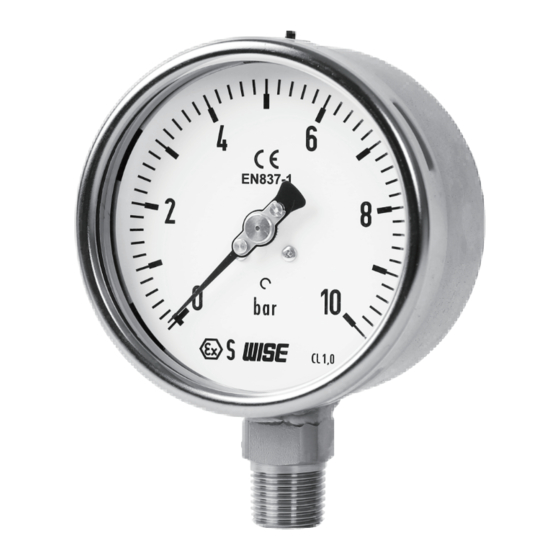
Table of Contents
Advertisement
Available languages
Available languages
Quick Links
Advertisement
Chapters
Table of Contents

Subscribe to Our Youtube Channel
Summary of Contents for Wise P257
- Page 1 Solid Front Gauge Manual P257 P359...
-
Page 2: Table Of Contents
01. OVERVIEW 02. PRODUCT CHARACTERISTICS 03. SPECIFICATIONS AND STANDARDS 04. NAME OF PARTS AND FUNCTIONS 05. PRINCIPLES 06. MAINTENANCE AND PRECAUTIONS 07. INSTALLATION 08. OPERATING INSTRUCTIONS... - Page 3 Instructions for Proper and Safe Operation Please read instructions carefully prior to using the instrument for proper and safe operations. Mishandling could cause device malfunctions and result in disastrous injuries or accidents. ■ WARNING Do not exceed the pressure range allowed. Do not use it to measure the pressure of corrosive fluid.
-
Page 4: Overview
1. Overview P257 is pressure gauge of safety pattern type, Stainless Steel Case and cover material is prevent corrosion or chemical attack is an excellent product. P359 is a 4-1/2" pressure gauge of safety pattern type. Its liquid end is of corrosion-resistant stainless steel. Case is made of thermoplastic resin ( PBTB ) which is more durable than stainless steel in corrosive environment. -
Page 5: Name Of Parts And Functions
4. Name of Parts and Functions NAME NAME CASE POINTER HEAD COVER SCALE PLATE SAFETY GLASS CONTROL SCREW PACKING BOURDON CAP BACK COVER MOVEMENT PLATE SHANK O-RING ORIFICE BOURDON TUBE FRONT PLATE POINTER... - Page 6 5. Operating Principle When pressure is applied to the Bourdon tube, it extends vertically. This vertical movement of Bourdon tube is delivered to the movement, and the movement changes this vertical movement into a roating motion. Movement is consist of lever and gear, and its main role is converting vertical movement into a rotation motion.
-
Page 7: Maintenance And Precautions
6. Maintenance and Precautions If corrosive fluid is used, diaphragm of proper material should be used to prevent corrosion. (Figure 1) In case of remote reading diaphragm type, diaphragm and the gauge has to be installed in the same plane. If not, please calibrate. In case the fluid is hot, install siphon to bring down to proper temperature. -
Page 8: Installation
7. Installation Avoid places with excessive moisture, vibration, dust or corrosive gas. Avoid areas that might exceed the temperature range specified in this manual. Protection from lightning or steam should be carefully reviewed and prepared. Avoid areas with direct sun light. Use M5 nut if installed on a panel or wall using mounting groove. -
Page 9: Operating Instructions
8. Operating Instructions Check presence of vibration, pulsation or heat in pipe lines and determine whether to use accessary, or select products with capillary or other oil types. (Figure 9) Always make sure the gauge is calibrated to zero prior to installation. Use Teflon tape or gasket on screws for extra firmness. - Page 11 Solid Front Gauge Manual P257 P359...
- Page 12 한국어 01. 개요 02. 특징 03. 사양 및 규격 04. 각 부의 명칭과 기능 05. 동작원리 06. 보수 및 사용상의 주의사항 07. 설치방법 08. 사용방법...
- Page 13 한국어 바르고 안전한 사용을 위한 취급 설명서 이 제품을 바르고 안전하게 사용하기 위하여 사용 전에 이 취급 설명서를 잘 읽어주시기 바랍니다. 취급 시의 오류는 기기 고장의 원인이 되며, 상해나 사고 등의 재해가 발생할 수 있습니다. ■ 경고 압력 범위를 초과하는 압력을 가하지 마십시오. 부식성이...
-
Page 14: 사양 및 규격
한국어 1. 개요 P257은 Solid Plate Wall과 Blow Out Back 타입으로, 케이스와 커버 재질이 Stainless Steel로 화학적 침식이나 부식 방지에 탁월한 제품입니다. P359는 Safety Pattern 타입의 4-1/2" 압력계로 접액부가 내식성이 큰 Stainless Steel로 되어 있으며 Case는 열가소성수지(PBTB)로 되어 있어 Stainless Steel보다 부식성 환경에 잘 견디도록 설계되었습니다. -
Page 15: 각 부의 명칭과 기능
한국어 4. 각 부의 명칭과 기능 번호 명칭 번호 명칭 CASE POINTER HEAD COVER SCALE PLATE SAFETY GLASS CONTROL SCREW PACKING BOURDON CAP BACK COVER MOVEMENT PLATE SHANK O-RING ORIFICE BOURDON TUBE FRONT PLATE POINTER... -
Page 16: 동작원리
한국어 5. 동작원리 부르동관은 압력을 상하 변위량으로 바꾸며 내기를 이용하여 변위량을 크게 확대하고 회전으로 바꾼다. 내기는 레버와 기어로 구성되며 부르동관의 직선적 변위를 회전 운동으로 바꾸는 역할을 한다. 일반적으로 부르동관의 변위량은 약 3~4 mm의 변위량이 발생하도록 설계 하며 이 변위량을 270˚의 회전각으로 압력을 지시하도록 하는 원리이다. 따라서... - Page 17 한국어 6. 보수 및 사용상 주의사항 유체에 부식제가 포함되어 있으면 부르동관으로 직접 전달되어 튜브가 손상될 수 있습니다. 따라서 사용자는 “Diaphragm Seal Type” 압력계를 선택하는 것이 좋습니다.(그림 1) 리모트 씰형 압력계의 경우 리모트 씰은 압력계가 설치된 라인과 동일한 라인에 설치해야 합니다. 그렇지 않은 경우 게이지에서 영점 조정 프로세스를 수행해야 합니다. 게이지가...
-
Page 18: 설치방법
한국어 7. 설치방법 습기, 진동, 먼지, 부식성 가스 등 적은 장소를 선택하여 설치하십시오. 본 취급설명서에서 규정한 주위 온도를 초과하는 장소를 피하십시오. 번개나 증기로부터 게이지를 보호할 대비를 하십시오. 직사광선이 있는 장소는 피하십시오. 도압관용 배관은 압력계에 무리가 가지 않도록 플렉시블 튜브 (Flexible Tube)를 사용하십시오. 배관에... -
Page 19: 사용방법
한국어 8. 사용방법 배관 라인에 진동 및 맥동 또는 고온인지 여부를 확인하여 필요시 악세서리와 같이 사용하거나 Capillary를 이용한 제품 또는 오일 타입을 선정해서 사용해야 합니다. (그림 9) 설치 하기 전 게이지의 0점이 맞는지 확인 하여 주십시오. 설치 시 나사에 테플론 테이프나 개스킷을 이용하여 견고하게 설치하여 주십시오. 설치가...












Need help?
Do you have a question about the P257 and is the answer not in the manual?
Questions and answers